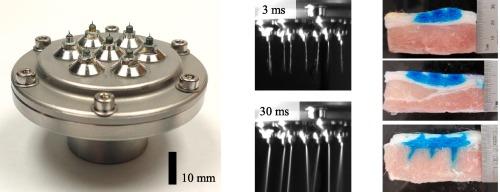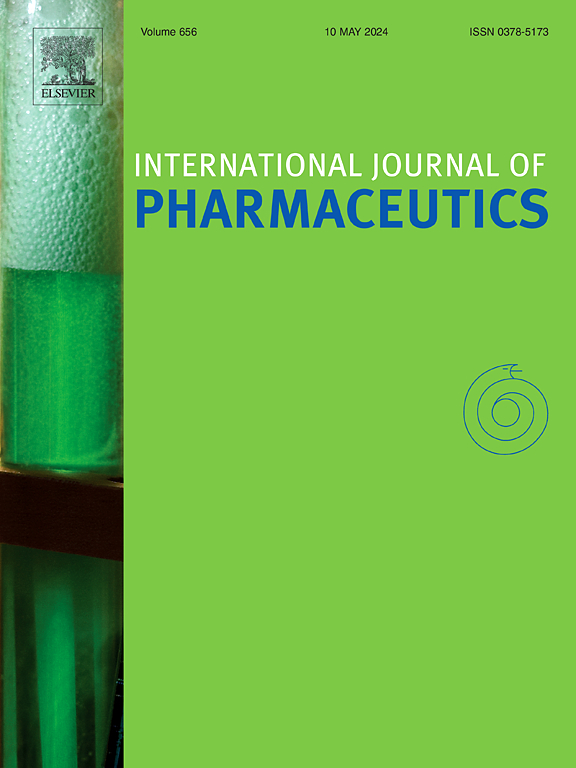通过微针进行大容量皮下注射。
IF 5.3
2区 医学
Q1 PHARMACOLOGY & PHARMACY
引用次数: 0
摘要
与静脉注射(IV)相比,皮下注射(SC)给药具有多种优势,包括:可自行给药、改善患者体验和降低治疗成本。遗憾的是,目前每次皮下给药的量仅限于 2.25 毫升,当给药量超过这个值时,就需要静脉给药。在这项工作中,我们探索了一种大容量皮下给药的新技术,该技术使用微针穿透表皮,然后将液体药物形成许多小喷流,穿过微针末端渗透到皮下(或肌肉)组织中。通过同时进行多次注射,这种给药方法避免了皮下注射给药的体积限制,因此可以大大增加这一空间的给药量。在这里,我们展示了一种新型多射流原型,它通过 30G 的针头同时形成七个射流,这些针头经过缩短,暴露长度仅为 1 毫米。我们测量了通过这些微针形成的射流的速度、形状和体积,以评估通过微针产生射流的一致性。然后,我们对活体猪组织进行了最大 3.9 mL 的喷射注射。结果表明,通过微针进行喷射注射,在短短 0.3 秒内就成功输送了 3.9 毫升(>95%)。这一注射量几乎是目前自动注射器最大注射量和皮下注射认知极限(2.25 毫升)的两倍。我们还发现,在我们的原型系统中,70 米/秒及以下的射流速度并不能完全达到 3.9 毫升的注射量,而与同等的无针注射相比,添加微针可实现更稳定的大容量注射。这些结果表明,通过微针进行多射流注射有望容纳比现有自动注射器大得多的容量,从而有可能在更多的给药应用中实现病人的自我给药。本文章由计算机程序翻译,如有差异,请以英文原文为准。

Jet injection through microneedles for large volume subcutaneous delivery
Subcutaneous (SC) drug delivery offers several advantages over intravenous (IV) delivery including: self-administration, improved patient experience, and reduced treatment costs. Unfortunately, each SC delivery is currently limited to ∼ 2.25 mL with IV administration required when the delivery volume exceeds this value. In this work, we explore a new technique for large volume subcutaneous drug delivery that uses microneedles to break through the epidermis then forms the liquid drug into many small jets that penetrate past the ends of the microneedles and into the subcutaneous (or muscle) tissue. By performing multiple simultaneous injections, this delivery approach avoids the volume limitations of SC delivery, and thus may be able to greatly increase the volume we can deliver to this space. Here, we present a novel multi-jet prototype that forms seven simultaneous jets through 30G needles that have been shortened to have an exposed length of just ∼ 1 mm. The jet speed, shape, and volume of jets formed through these microneedles are measured to assess the consistency of jet production through the microneedles. We then perform jet injections of volumes up to 3.9 mL into ex vivo porcine tissue. The results demonstrate the successful delivery (>95 %) of 3.9 mL in just 0.3 s using jet injection performed through microneedles. This volume is almost double the maximum volume of current autoinjectors and the perceived limit for subcutaneous injection (2.25 mL). We also find that jet speeds of 70 m/s and below do not achieve complete delivery of 3.9 mL with our prototype system, and that the addition of microneedles leads to more consistent large volume delivery than equivalent needle-free injections. These results demonstrate the promise of multi-jet injection through microneedles to accommodate volumes much greater than current autoinjectors, and thus potentially allow patient self-administration in many more delivery applications.
求助全文
通过发布文献求助,成功后即可免费获取论文全文。
去求助
来源期刊
CiteScore
10.70
自引率
8.60%
发文量
951
审稿时长
72 days
期刊介绍:
The International Journal of Pharmaceutics is the third most cited journal in the "Pharmacy & Pharmacology" category out of 366 journals, being the true home for pharmaceutical scientists concerned with the physical, chemical and biological properties of devices and delivery systems for drugs, vaccines and biologicals, including their design, manufacture and evaluation. This includes evaluation of the properties of drugs, excipients such as surfactants and polymers and novel materials. The journal has special sections on pharmaceutical nanotechnology and personalized medicines, and publishes research papers, reviews, commentaries and letters to the editor as well as special issues.

 求助内容:
求助内容: 应助结果提醒方式:
应助结果提醒方式:


